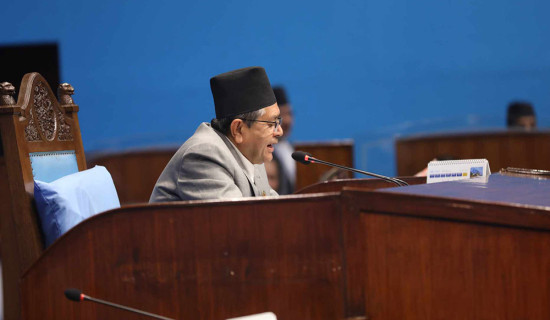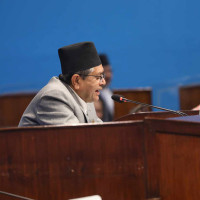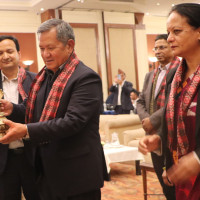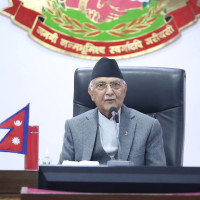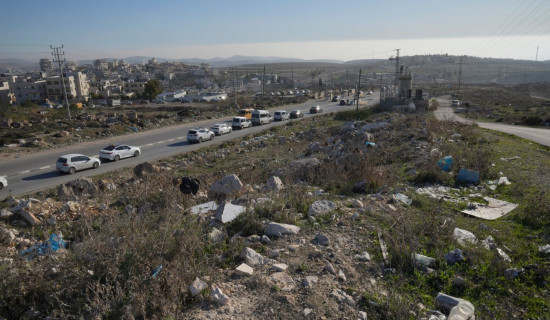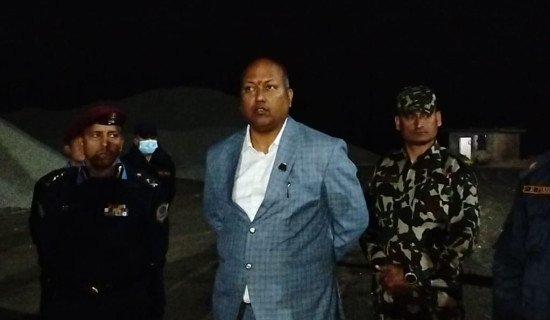- Wednesday, 12 February 2025
Govt strives to enhance disaster preparedness to better protect lives, property
PURUSHOTTAM P. KHATRI,Kthmandu, June 16: Just a day after the onset of monsoon from the eastern Nepal, it has already started taking toll on human life while destroying properties worth millions in different parts of the country.
A landslide triggered by Thursday night’s incessant rains in Phaktanglung Rural Municipality-2 of Taplejung district claimed four lives on Friday morning.
Along with the monsoon clouds, the season brings natural disasters—landslides, floodings, inundations, embankment breaches, thunderstorms, snakebites, and a host of water-borne diseases.
This year, the country is likely to witness above-normal rainfall as predicted by the meteorologists. But that does not mean all areas across the country will see equal rainfall. Some places could witness massive rainfall, others may face drought, while dry-spell-like conditions could be seen in other places, experts viewed.
As natural calamities fuelled by erratic weather patterns become more frequent and pronounced, the country could witness more incidents of disasters during the monsoon, hydrologists and weathermen cautioned.
Accordingly, the National Disaster Risk Reduction and Management Authority (NDRRMA) under the Ministry of Home Affairs has estimated that at least 1.8 million people would be affected by natural disasters during the monsoon. The authority has already directed all those concerned to start preparations.
Anil Kumar Pokhrel, Chief Executive Officer for the NDRRMA said, it was always good and ideal when there are no disaster incidents. "However, human-made structures and unplanned urban development make us vulnerable to natural disasters," said Pokhrel.
He said that this year, the government has kept 31,356 personnel (10,847 of Nepali Army, 9,924 of APF and 10,585 of Nepal Police), in ready position for immediate relief, rescue, and operation during monsoon disasters.
The NDRRMA has kept helicopters of Nepali Army on the standby at five locations for rescue and relief, established central command post led by Joint Secretary Dr. Bhishma Kumar Bhusal for 24-hour emergency operation and monitoring, established 12 humanitarian assistance centres in seven provinces, including Kathmandu, managed toll-free number 1149, arranged SMS alert to locals before the rivers exceed danger levels, and drones to assess the damage from floods and inundation.
Experts, however, are skeptical of the country’s capacity to handle large-scale disasters as the relevant agencies have not learned from the past disasters. They have warned that the continuation of the reactive approach (springing into action only after disasters) will cause huge losses to the people as well as the country.
Nepal’s vulnerability to natural disasters
In the last five years from 2018, 1,427 people were killed by different monsoon-induced disasters, according to the NDRRMA. Similarly, property worth Rs. 5.91 billion was destroyed during the period.
Nepal ranks 11th and 16th globally in terms of vulnerability to earthquakes and multi-hazards respectively, according to UNICEF Nepal.
In the spring, the country witnessed incidents of massive forest fires. At least, 17 people died and dozens others injured in forest fires only in the last six months from December 14, 2023 to June 14, 2024.
Geologist, earthquake expert and former deputy-director general at the Department of Mines and Geology Dr. Somnath Sapkota said landslides have always become the main reason for loss of human lives every year during the time of monsoon.
"The main reason for this is because of fragile and cracked lands in many places of the country because of several big earthquakes and infrastructure development and hydropower works," Dr. Sapkota said.
Monsoon mayhem projection
The Monsoon Action Plan for this year reads, "It is estimated that 1.8 million people could be affected by this monsoon. It is estimated that 83,000 households could be directly affected by monsoon-related disasters only, and 18,000 households may need immediate rescue and relief."
Settlements at high risk of landslides
The Authority has identified settlements at high risk of landslides in all seven provinces. Six settlements have been identified as high risk of landslides in the Koshi Province.
In Taplejung, two settlements in Mewakhola Rural Municipality, seven settlements in Sidingwa Rural Municipality, six settlements in Phalgunanda Rural Municipality in Panchthar, one settlement in Miklajung Rural Municipality, and two settlements in Tumbewa Rural Municipality have been pointed out by the Authority as being at high risk.
Similarly, one settlement in Okhaldhunga in Koshi Province also needs to be relocated.
Under Bagmati Province, seven settlements in Tamakoshi Rural Municipality in Dolakha, some settlements in Bigu, Gaurishankar, and Kalinchok Rural Municipalities have been identified as risk-prone.
Four settlements in Tripurasundari Rural Municipality in Sindhupalchok, thirty-one settlements in Barhabise Municipality in Sindhupalchok, some settlements in Bhotekoshi Rural Municipality, and one settlement in Balefi Rural Municipality are at risk, according to the Authority.
In Rasuwa, nine settlements in Naukunda Rural Municipality, and one settlement in Tarkeshwar Municipality in Kathmandu have been identified as vulnerable.
In Gandaki, two settlements in Chumanuwri Rural Municipality in Gorkha, and some settlements in Arughat Rural Municipality have been identified as risk-prone.
In Parbat, one settlement with eight houses in Jaljala Rural Municipality, and five settlements in Mangala Rural Municipality in Myagdi are at risk. One settlement each in Bhimad Rural Municipality and Byas Municipality in Tanahun have been identified as risk-prone.
In Lumbini Province, one settlement in Nisdi Rural Municipality in Palpa is at risk. In Karnali, 200 settlements in seven municipalities affected by the earthquake in Jajarkot have been identified as vulnerable.
In Rukum West, 130 settlements are also identified as risk-prone.
In Sudurpaschim Province, eight settlements in Alital in Dadeldhura and one settlement in Jagannath Rural Municipality are at risk.
Among these, it is mentioned that cracks where water might enter and places prone to landslides should be sealed before the rains in coordination with local levels. It is also suggested to link this work with the Prime Minister's Employment Programme.
Nepal’s handling of disasters
Every year, floods and landslides cause huge losses of life and property, but the country’s disaster preparedness is still poor, said Dr. Ranjan Kumar Dahal, an engineering geologist specialiszing in geo-hazard reduction.
Over the past few years, it has been receiving more rainfall in short durations—an abnormal phenomenon that is slowly becoming the new normal.
However, many incidents of disasters in the past exposed the government’s lack of preparedness, he said.
Displaced people had been compelled to live in makeshift shelters set up after the disasters, some built near the damaged houses in risky zones. Many are still living in such shelters.
State of preparations this year
NDRRMA, the central resource body for disaster management, said it had prepared a response plan for the monsoon. Monsoon Preparedness and Action Plan-2081 has just been introduced and come into effect from last week. Such a plan needs to be made with a bottom-up approach involving every ward, municipality, disaster response authority in the districts, as well as the provinces and federal government agencies.
“As the local government units are first responders to any natural disaster, they should do risk mapping and planning first,” said Dijan Bhattarai, Under-Secretary and Spokesperson for the Authority. “However, we (a federal government agency) did our risk mapping first, as the local and provincial government agencies took much time to carry out their risk mapping. It would have been more scientific had the local and provincial agencies done their planning first,” he said.
Officials said agencies under 10 ministries, including the Ministry of Home Affairs, Ministry of Health and Population, Ministry of Urban Development, and Ministry of Water Supply, which are generally involved in disaster response, have been kept in high alert position, Bhattarai said.
Experts’ take
Experts have said the government’s responsibility goes beyond formulating policies and guidelines. When disasters strike in far-flung and remote areas, rescuers cannot reach there immediately and local residents work as first responders. But they lack training and are ill-equipped. That leads to loss of lives and property that could be prevented, they added.
“Most agencies under local units are ill-equipped and lack the expertise to handle disaster-related incidents,” said Santwona Devkota, a disaster risk reduction trainer. “Such agencies should get training, equipment and funds. We tend to wait until the disaster strikes. We cannot cut losses through such a reactive approach.”
After casualties and loss of properties, the agencies spring into action. And then after a few months, everyone forgets. Experts said only an effective monsoon preparedness plan can save lives and properties.
“Besides arranging for necessary things, federal government agencies should also coordinate among the agencies under local and provincial governments,” said Devkota.
“Early warning systems should be made effective and attention should be given to raising awareness of the risks.”
Local units should be advised to work proactively to respond to disaster-related incidents. For that, they can stockpile goods, train volunteers, organise simulations and develop early warning systems.
“Each and every agency—Nepali Army, Nepal Police, Armed Police Force Nepal, non-governmental organisations—and agencies under the ministries have their own responsibilities,” said Devkota. “Those agencies should act proactively.”
Total funds for disaster response
The Authority has stated that there is a budget of Rs. 6.78 billion for disaster response this year. Of this amount, Disaster Management Fund for the 77 districts has a balance of Rs. 1.255 billion.
Out of this, 14 districts of Koshi have a balance of Rs. 43.25 million. The eight districts of Madhes have a balance of Rs. 334.84 million.
The 13 districts of Bagmati have a balance of Rs. 123.87 million. The 11 districts under Gandaki have Rs. 23.32 million for disaster mission.
The 12 districts of Lumbini have Rs. 27.98 million. Similarly, the 10 districts of Karnali have Rs. 520.47 million. The funds of the nine districts in Sudurpaschim Province have a balance of Rs. 182.25 million.
Likewise, the Prime Minister's Disaster Relief Fund has separate balance of Rs. 1 billion, while the Provincial Disaster Management Fund has a separate Rs. 847.7 million.
Local-level Disaster Management Committees are also in place in 440 local levels, with a balance of Rs. 2.01 billion, according to the Authority.
Landslides, thunder strikes and flooding
Heavy rainfall triggers landslides in the districts of hilly regions and several districts in the Tarai region get inundated in every monsoon. During last year’s monsoon, 102 people—53 male and 49 female—died and 19 were reported missing in landslides.
According to the NDRRMA, 96 people were injured in various incidents of landslides, 2,004 families were affected, 1,017 private houses were partially damaged while 865 houses were destroyed by landslides.
On April 13, the Department of Hydrology and Meteorology predicted that there will be more than average rainfall during this monsoon season. This projection is based on studies by the Department of Water and Meteorology, the World Meteorological Organisation, and the South Asian Meteorologists' Association.
The Department said that there is a 35 to 55 per cent chance of above-average rainfall in most parts of the country during the upcoming monsoon season.
Similarly, it projected a 35 to 45 per cent chance of average rainfall in the northwestern part of Sudurpaschim Province, the southeastern part of Bagmati Province, the central part of Madhes Province, and the central and mid-western parts of Koshi Province.
Last year's monsoon season had below-average rainfall.
From June 1, 2023 to September 30, there was 1,303 millimeters of rainfall. According to the Department of Hydrology and Meteorology, only 88.5 per cent of the average rainfall occurred during that period, which should have been 1,472 millimeters.
This year, the winter season also saw minimal rainfall. Only 12.5 millimeters of rainfall occurred this year, while the average should have been 60.1 millimeters.



